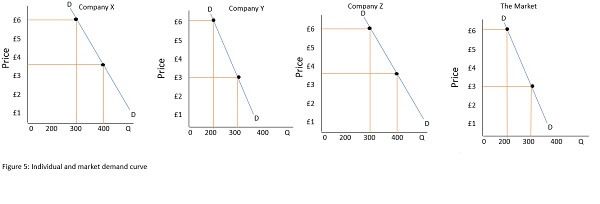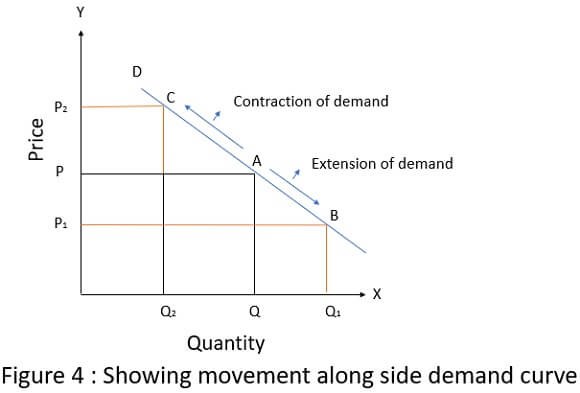Definition: Demand Curve is a precise set-up to describe the relation amidst price and quantity demanded. It is a graph representing the relationships between the price of a product and the quantity of product that customers are pleased with and ready to purchase at the given cost.
Demand Curve is drawn on the presumption that all the other factors of demand indexed earlier are retained consistent.
Demand Schedule| Price of Goods | Quantity demanded (in units) | Points in the graph |
|---|---|---|
| 60 | 5 | a |
| 50 | 7 | b |
| 40 | 10 | c |
| 30 | 15 | d |
| 20 | 20 | e |
In figure 1 below, the demand curve is drawn on the basis of data scheduled presented above.

Demand curve generally tilts downwards from left to right indicating a converse relationship between the price and the quantity demanded. And the downward tilt also demonstrates the “law of demand”, i.e., keeping other elements constant, the quantity demanded will rise with every fall in its price and the quantity demanded will decline with every increase in its cost. Any point on the demand curve signifies a specific price-quantity relationship.
Content: Demand Curve
- Demand Curve Example
- Why the demand curve tilts downwards?
- Shift in the Demand Curve
- Factors responsible for Shift in Demand Curve
- Movement Alongside a Demand Curve
- Individual and Market Demand Curve
- Conclusion
Demand Curve Example
Point “C” determines that when the price of a good is ₹ 40, the quantity demanded by the customer is 10 units. Similarly, assembling all five-point, i.e., a, b, c, d and e indicates the entire demand curve, which displays the perfect functional relation amidst price and quantity demanded.
Why the demand curve tilts downwards?
Earlier, the cardinal utility was the base of demand analysis. The demand curve tilts downwards primarily because of the law of diminishing marginal utility. In accordance with this law, an increased unit of product delivers low satisfaction. The customer will repeatedly see to relate the price of the product with the marginal utility he/she obtains from it. i.e., the customer will try to achieve the following symmetric situation at each point on the demand curve.
![]()
As, according to the law of diminishing marginal utility, each supplementary unit gives lower utility compared to the earlier units, the customer is inclined to pay only a lower price when he steps down the marginal utility curve as shown in figure 2(a) below.

Thus, the customer will purchase only when his symmetric situation is fulfilled. As displayed in figure 2(a) and figure 2(b) above, the demand curve tilts downwards as the marginal utility curve, and the customer is at symmetry at points where
Shift in the Demand Curve
If there is a change in demand because of elements, other than price, it is known as an increase or decrease in demand as the case may be. Corresponding changes in demand are displayed by depicting a demand curve to the right or left of the original demand curve; thus, it is termed as “Shift in the Demand Curve”. In the case of a rise in demand, there will be a rightward shift in the demand curve. It displays only quantity at an identical price. In the case of a reduction of demand, there will be a leftward shift in the demand curve. It displays a similar lower quantity at an identical price. Both the conditions are illustrated in figure 3 below, shifting from DD TO D1D1 (rightward) displays risk in demand and shifting from DD to D2D2 (leftward) displays the reduction in demand.
Factors responsible for Shift in Demand Curve
- Variation in customer’s income.
- Variation in the cost of related products.
- Variation in the taste, nature and fashion.
- Variation in the allocation of wealth.
- Variation in the stock of assets.
- Variation in climate and season.
- Variation in savings.
- Variation in population.
- Proposed variation in the future price of the product.
- Variation in the condition of trade.
- New replacement of products.
Movement Alongside a Demand Curve
If the quantity demanded rises or reduces because of fall or hike in the price of a product alone, it is termed as extension or contraction of demand. It is a case of movement along a demand curve. In case of extension of demand, we move from A to B, i.e., downward. And in the case of contraction, we move from A to C, i.e., upward, along with the same demand curve as displayed in figure 4 below:
Individual and Market Demand Curve
Earlier, it has been simulated that demand means demand for a commodity in a whole market. i.e., Market Demand. However, it is desirable to construct individual demand curves and extract market demand curves from them. An individual demand curve is the demand curve of an individual entity; this could be a customer, a company or a government. The factors of demand for a single entity are not distinct from these market as a whole. When prices increase, there is a decline in the demanded quantity of the commodity, when income increases domineering that the commodity is a normal good, demand will rise.
Figure 6, below displays a condition where only three purchasers are there in the market, company X, Y, and Z. At £3, company X will purchase 400 units, company Y 300 units and company Z 300 units. Thus, the overall market demand at £3 is 400+300+300 or 1000 units. At £6, total market demand will be 300+200+100 or 600 units. Correspondingly all the other points on the market demand curve can be obtained by computing the individual demand curves. It is termed horizontal summing as the figures on the horizontal axis of the individual demand curves are computed to put on the market demand curve. However, the physical structure on the vertical axis of both individual and market demand curves stay identical.

The market demand curve can be derived from the individual demand curves by adding up individual demand at every single price. In this example, the market demand at £3 is computed by adding the demand of firm X, Y, and Z at this price.
Conclusion
A demand curve is downward tilted, displaying that the lesser the price, the greater will be the quantity demanded of a product or commodity. The demand curve is drawn on the presumption that all the other factors of demand indexed earlier are retained consistent.


Leave a Reply